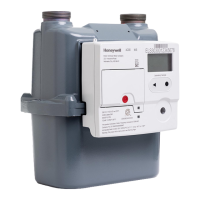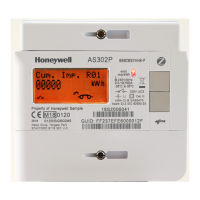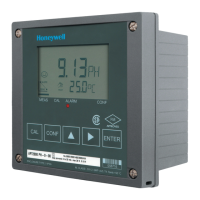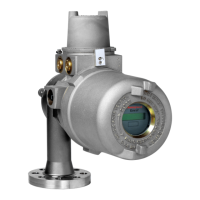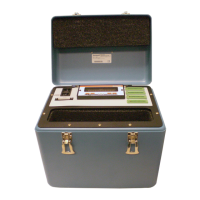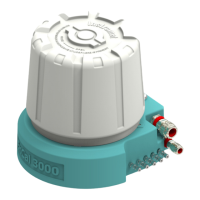34
Table 1 Shows the timing range for each flow cycle and the pressure or range of pressure
in the gas cell during the cycle.
Evacuation cycle: The ACM 150 monitor starts each sampling cycle by switching the
valves so that the Gas Cell Venturi Pump draws a vacuum on the gas cell. The inlet valve
to the gas cell is shut off. This creates a large vacuum in the gas cell and efficiently
removes the sample gas from the analyzed area. While the gas cell is evacuated, the
Boost Pump draws the sample air from the next area to be scanned, and its flow is diverted
to bypass.
Surge cycle: The Gas Cell Venturi Pump continues to draw on the gas cell, but now the
inlet valve to the gas cell is opened. This allows a surge of new samples from the Boost
Pump into the gas cell, replacing the sample from the last area scanned with a fresh
sample from the current area.
Fill cycle: The Gas Cell Venturi Pump valve is shut, and the gas cell fills with the new air
sample until it reaches atmospheric pressure. The gas cell can equilibrate to atmospheric
pressure before analysis begins. The calibrations for the measured components used to
develop the analytical methods are all done at atmospheric pressure. If the analysis were
not done at atmospheric pressure, the results would not be accurate.
Analyze cycle: The valves on the inlet and outlet of the gas cell are closed. The FTIR
analyzer collects the infrared spectrum of the current air sample. It sends it to the computer,
where the data is extracted from the spectrum and reported as gas concentrations.
This sequence is automatically repeated for each area sampled on a continuous 24-hour
cycle. It is only interrupted by Background scans or when the ACM 150 monitor is no
longer automatic.
3.4.2. Bypass and order of scan
When the ACM 150 monitor analyzes an air sample from an area, the corresponding
sample area number and name are displayed in the status bar on the touchscreen.
The sample valve for the next area in the scan sequence opens as soon as the Analyze
cycle begins. The Boost Pump draws the sample from that next area and bypasses it to
exhaust (S1 opens). This ensures that the internal tubing has been thoroughly purged of
the last sample and replaced with a fresh sample.
As the ACM 150 monitors samples and analyzes areas, another bypass flow continues
for all areas not currently sampled. This flow is drawn through the Sample Valves by the
Bypass Venturi Pump. A flow control orifice in each Sample Valve controls and balances
the flow rate. This assures a continuous flow through all the sample tubes to maintain
fresh, representative air samples.
The user may program the sample Areas to be analyzed in any order and even have some
of the Areas analyzed more than once per complete scan cycle. The Order of Scan
determines this. Some areas may also be scanned in groups, known as Composite
Sample Groups. This is done to accelerate the scan cycle. Refer to Settings Menu For
more information.
3.4.3. Background cycle
To sustain a permanent calibration for all monitored chemicals, periodically establishing a
baseline reference for the infrared spectrum is necessary. This is done by taking a

